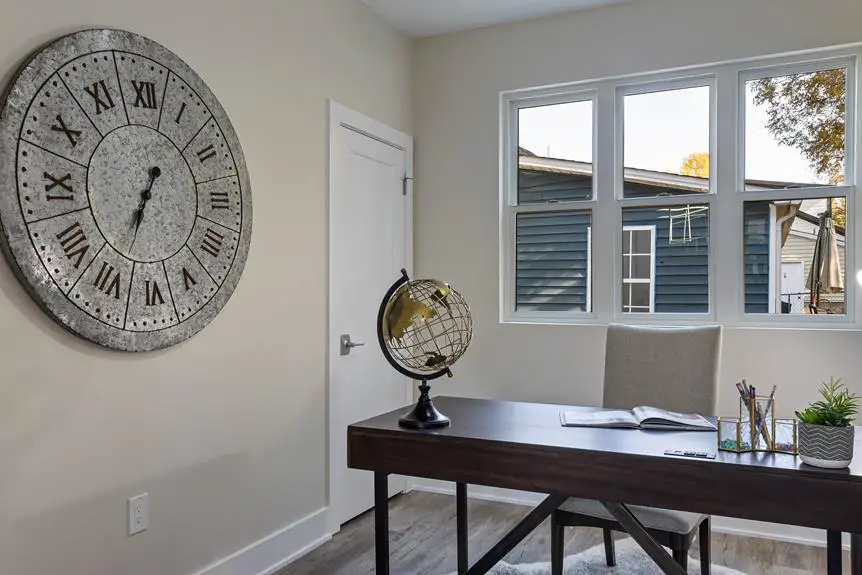You're ready to master the art of setting up your home office like a pro with VESA mountable solutions.
Just like a skilled craftsman carefully selects the right tools for the job, you need to know the essential tips for creating a VESA mountable home office setup.
From assessing your workspace to ensuring proper positioning for ergonomic benefits, these 7 must-know tips will elevate your home office game to the next level.
Get ready to optimize your workspace for productivity and comfort, as you learn how to choose the right VESA mount, manage cables, and maintain your setup for maximum efficiency.
It's time to transform your home office into a seamless, professional environment.
Key Takeaways
- Organize and declutter your workspace to maximize functionality
- Ensure compatibility of VESA mounts with monitors and weight capacity
- Position your monitor at eye level for optimal ergonomics
- Properly manage cables and power supply for a neat and efficient workspace
Assessing Your Workspace
Before mounting your monitors, assess your workspace for the most ergonomic and efficient setup. Start by organizing your workspace to minimize clutter and maximize functionality. Ensure that your desk is clear of unnecessary items and that essential tools and documents are within easy reach. Consider implementing storage solutions such as shelves, drawers, or filing systems to keep your workspace tidy and organized.
Next, evaluate your lighting situation. Adequate lighting is crucial for reducing eye strain and maintaining focus. Position your desk near a natural light source, if possible, and supplement with adjustable desk lamps to provide consistent and adjustable illumination. Consider investing in lighting solutions that mimic natural daylight to create a more comfortable and productive work environment.
Choosing the Right VESA Mount
When choosing the right VESA mount for your home office setup, it's important to consider the compatibility with your monitors and the weight capacity of the mount.
Assess the size and weight of your monitors to ensure they're compatible with the VESA mount you choose. Additionally, be sure to check the weight capacity of the mount to ensure it can safely support your monitors.
Compatibility With Monitors
To ensure compatibility with your monitor, start by identifying its VESA mount pattern. This pattern is crucial for selecting the right VESA mount. Check the back of your monitor for the VESA mount pattern, which consists of a sequence of four threaded mounting holes. Once you have this information, you can choose a VESA mount that matches your monitor's pattern. Use the table below to find the compatible VESA mount options based on your monitor size and VESA adapter.
| Monitor Size (Inches) | VESA Adapter | Compatible Devices | Mounting Options |
|---|---|---|---|
| 20-24 | Included | Monitors, TVs | Desk, Wall |
| 25-29 | Additional | Monitors, TVs | Desk, Wall |
| 30-34 | Not Needed | Monitors, TVs | Desk, Wall, Arm |
Weight Capacity Considerations
Consider the weight capacity of your monitor when selecting the appropriate VESA mount. It's crucial to ensure that the mount can support the weight of your monitor. When determining the weight capacity, take into account not only the weight of the monitor but also the weight distribution.
Larger monitors generally weigh more, so if you have a larger monitor, you'll need a mount with a higher weight capacity. Additionally, consider the weight distribution of your monitor, as some mounts may have specific weight distribution requirements.
Always check the specifications of the VESA mount to ensure that it can safely support your monitor's size and weight.
Ensuring Compatibility With Your Devices
Make sure your devices are VESA compatible before investing in a VESA mount for your home office setup. Ensuring compatibility is crucial for a seamless integration of your devices. Here are some key factors to consider:
- Device Compatibility: Check if your monitors, all-in-one PCs, or other devices have VESA mounting capability. Look for the VESA mount pattern specifications in the product manual or on the manufacturer's website. Without VESA compatibility, you may need to explore alternative mounting solutions.
- Weight and Size: Ensure that the VESA mount you choose can support the weight and size of your devices. Exceeding the weight limit can lead to instability and potential damage to your equipment.
- Cable Management: Consider how the VESA mount will affect cable management. Some mounts offer built-in cable management features, while others may require additional accessories to keep cables organized and out of the way.
- Future Expansion: If you plan to upgrade or add devices to your setup in the future, opt for a versatile VESA mount that can accommodate a range of devices. This foresight will save you from having to reinvest in mounts as your setup evolves.
Proper Positioning for Ergonomic Benefits
Achieve optimal ergonomics by positioning your monitor at eye level using a VESA mount. Proper posture is essential for minimizing strain on your neck and back, and achieving an ideal viewing angle can greatly contribute to this. When your monitor is positioned at eye level, you can maintain a neutral neck position, reducing the risk of discomfort or pain. Additionally, ensure that your monitor is at arm's length away from you. This distance helps to prevent eye strain and allows for comfortable viewing without having to lean forward or backward.
Furthermore, consider your seating arrangement. Your chair should be adjusted so that your feet are flat on the floor, knees are at a 90-degree angle, and your lower back is properly supported. This setup promotes proper posture and reduces the risk of back pain.
Managing Cables and Power Supply
To maintain a clutter-free and efficient workspace, ensure that all cables and power supply connections are neatly organized and secured. Organizing cables and managing power supply is crucial for a streamlined home office setup.
Here are some essential tips to master cable and power management:
- Cable Management: Use cable ties, sleeves, or clips to bundle and route cables neatly along the desk or wall. This not only prevents tangling but also makes it easier to identify and access specific cables when needed.
- Power Strip Placement: Position a surge protector or power strip near the VESA mount to conveniently plug in your monitor, computer, and other peripherals. Opt for a power strip with individual switches to control the flow of power to each device.
- Concealment: If possible, conceal cables behind the desk or use cable management trays to keep them out of sight. This creates a clean and professional look while reducing the risk of tripping over loose wires.
- Labeling: Labeling cables at both ends can save time and frustration when troubleshooting or reconfiguring your setup. Use color-coded tags or labels to easily identify different cables and their respective devices.
Implementing these strategies won't only enhance the aesthetics of your workspace but also contribute to a more organized and efficient home office environment.
Securing the Mount Properly
When securing the VESA mount, ensure it's firmly attached to the wall or desk for stability and safety. Proper installation is crucial to prevent any accidents or damage to your equipment.
Start by selecting the appropriate screws and anchors for the type of wall or desk material you're mounting the VESA bracket onto. Make sure to follow the manufacturer's guidelines for weight limits and recommended installation methods.
Use a level to ensure the mount is straight and aligned properly before securing it in place.
Additionally, consider using safety precautions such as adding a safety tether to provide extra support and prevent the monitor from falling in case the mount fails.
It's also essential to periodically check the mount's stability and re-tighten any screws if needed.
Regular Maintenance and Adjustments
To maintain the stability and functionality of your VESA mountable home office setup, regular maintenance and adjustments are essential. By following a consistent maintenance schedule and employing proper adjustment techniques, you can ensure that your setup remains in top condition.
Here are some key tips to help you master the art of maintaining and adjusting your VESA mountable home office setup:
- Regular Inspection: Regularly inspect the mount, monitor, and all attached components for any signs of wear and tear. Look out for loose screws, damaged parts, or any other issues that may affect the stability of the setup.
- Cleaning Routine: Establish a cleaning routine to keep the mount and monitor free from dust and debris. Use a microfiber cloth and gentle cleaning solutions to prevent dirt buildup, which can affect the functionality of the mount.
- Proper Adjustment Techniques: Learn and practice proper adjustment techniques to ensure that your monitor is positioned ergonomically and securely. This includes adjusting the height, tilt, and swivel of the monitor to reduce strain and improve comfort during long work hours.
- Scheduled Maintenance: Set a regular schedule for maintenance tasks, such as tightening screws, checking cable connections, and repositioning the monitor as needed. Consistent maintenance will help prevent issues and prolong the lifespan of your VESA mountable home office setup.
Frequently Asked Questions
How Can I Customize My VESA Mount to Match the Aesthetic of My Home Office?
You can customize your VESA mount to match your home office aesthetic by exploring various customizable options such as color, material, and design integration. Consider coordinating with your office decor for a seamless look.
Are There Any Specific VESA Mount Options for Standing Desks or Adjustable Height Workstations?
Yes, there are VESA-compatible mounts for standing desks and adjustable height workstations. Ensure the mount's arm length and weight capacity suit your monitor. Look for options with flexible and sturdy designs to accommodate your specific setup.
Can I Use a VESA Mount for a Curved Monitor or Ultrawide Display?
Yes, you can use a VESA mount for a curved monitor, but make sure it's compatible. Ultrawide display options are available too, just ensure the mount supports the size and weight of your monitor.
Are There Any VESA Mount Solutions That Include Built-In USB Hubs or Charging Ports?
Yes, there are VESA mount accessories with built-in USB hubs for convenient connectivity. They also offer cable management solutions and aesthetic customization opportunities, making them ideal for streamlined and organized home office setups.
What Are Some Tips for Organizing and Concealing Cables When Using a VESA Mount in a Home Office Setup?
To manage cables when using a VESA mount, consider cable management solutions such as cable clips or sleeves. Keep your desk organized by using adhesive cable holders and routing cables behind your monitor stand.




